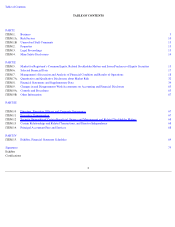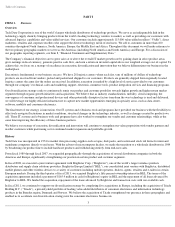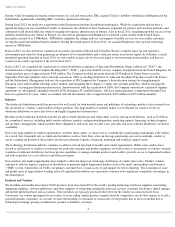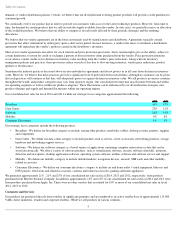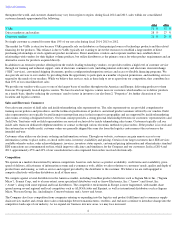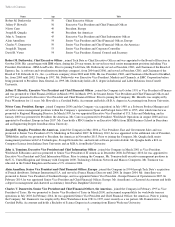Tech Data 2014 Annual Report Download - page 13
Download and view the complete annual report
Please find page 13 of the 2014 Tech Data annual report below. You can navigate through the pages in the report by either clicking on the pages listed below, or by using the keyword search tool below to find specific information within the annual report.
Table of Contents
If our vendors do not continue to provide price protection for inventory we purchase from them our profit from the sale of that
inventory will decline.
It is very typical in our industry that the value of inventory will decline as a result of price reductions by vendors or technological obsolescence.
It is the policy of most of our vendors to protect distributors from the loss in value of inventory due to technological change or the vendors' price
reductions. Some vendors, however, may be unwilling or unable to pay the Company for price protection claims or products returned to them
under purchase agreements. Moreover, industry practices are sometimes not embodied in written agreements and do not protect the Company in
all cases from declines in inventory value. No assurance can be given that such practices to protect distributors will continue, that unforeseen
new product developments will not adversely affect the Company, or that the Company will be able to successfully manage its existing and
future inventories.
Failure to obtain adequate product supplies from our largest vendors, or terminations of a supply or services agreement, or a significant
change in vendor terms or conditions of sale by our largest vendors will negatively affect our revenue and operating profit.
The Company receives a significant percentage of revenues from products it purchases from certain vendors, such as Hewlett-Packard Company
and Apple, Inc. These vendors have significant negotiating power over us and rapid, significant and adverse changes in sales terms and
conditions, such as reducing the amount of price protection and return rights as well as reducing the level of purchase discounts and rebates they
make available to us, may reduce the profit we can earn on these vendors' products and result in loss of revenue and profitability. The Company's
gross profit could be negatively impacted if the Company is unable to pass through the impact of these changes to the Company's customers or
cannot develop systems to manage ongoing vendor programs. In addition, the Company's standard vendor distribution agreement permits
termination without cause by either party upon 30 days notice. The loss of a relationship with any of the Company's key vendors, a change in
their strategy (such as increasing direct sales), the merging of significant vendors, or significant changes in terms on their products may
adversely affect the Company's business.
Changes in our credit rating or other market factors may increase our interest expense or other costs of capital or capital may not be
available to us on acceptable terms to fund our working capital needs. The inability to obtain such sources of capital could have an
adverse effect on the Company's business.
The Company's business requires substantial capital to operate and to finance accounts receivable and product inventory that are not financed by
trade creditors. The Company has historically relied upon cash generated from operations, bank credit lines, trade credit from vendors, proceeds
from public offerings of its common stock and proceeds from debt offerings to satisfy its capital needs and finance growth. The Company
utilizes various financing instruments such as receivables securitization, leases, revolving credit facilities and trade receivable purchase
agreements. As the financial markets change and new regulations come into effect, the cost of acquiring financing and the methods of financing
may change. Changes in our credit rating or other market factors may increase our interest expense or other costs of capital or capital may not be
available to us on acceptable terms to fund our working capital needs. The inability to obtain such sources of capital could have an adverse effect
on the Company's business. The Company's credit facilities contain various financial and other covenants that may limit the Company's ability to
borrow, or limit the Company's flexibility in responding to business conditions. These financing instruments involve variable rate debt, thus
exposing the Company to risk of fluctuations in interest rates. Increases in interest rates would result in an increase in the interest expense on the
Company's variable debt, which would reduce the Company's profitability.
We conduct business in countries outside of the United States, which exposes us to fluctuations in foreign currency exchange rates that
result in losses in certain periods.
The Company conducts business in countries outside of the United States, which exposes the Company to fluctuations in foreign currency
exchange rates. The Company may enter into short-term forward exchange or option contracts to hedge this risk. Nevertheless, volatile foreign
currency exchange rates increase our risk of loss related to products purchased in a currency other than the currency in which those products are
sold. While we maintain policies to protect against fluctuation in currency exchange rates, extreme fluctuations have resulted in our incurring
losses in some countries. The realization of any or all of these risks could have a significant adverse effect on our financial results. In addition,
the value of the Company's equity investment in foreign countries may fluctuate based upon changes in foreign currency exchange rates. These
fluctuations, which are recorded in a cumulative translation adjustment account, may result in losses in the event a foreign subsidiary is sold or
closed at a time when the foreign currency is weaker than when the Company made investments in the country. In addition, our local competitors
in certain markets may have different purchasing models that provide them reduced foreign currency exposure compared to the Company. This
may result in market pricing that the Company cannot meet without significantly lower profit on sales.
11



